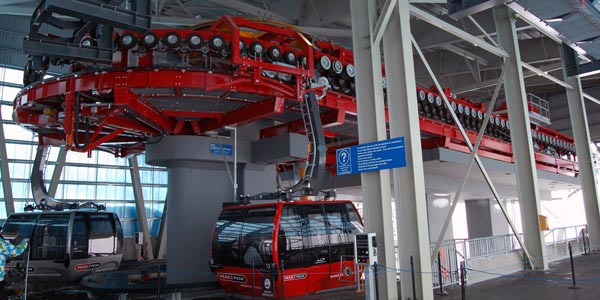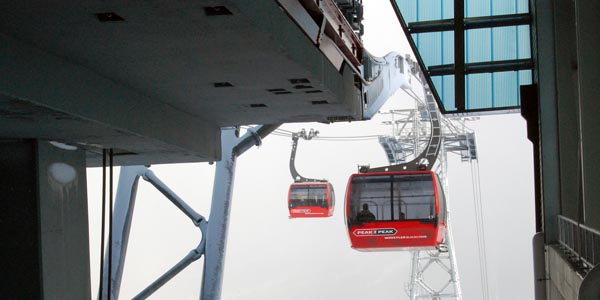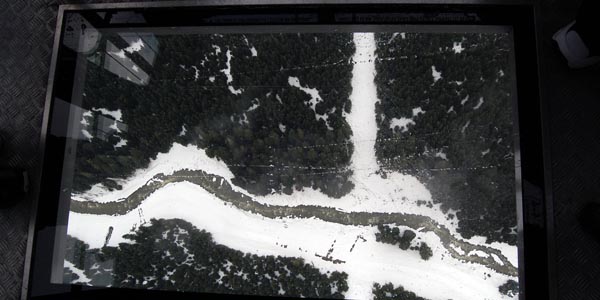Last month I toured Whistler’s Peak 2 Peak cable gondola system. This is Part 2 of a 3-part series on the system. Click on the following link to view Part 1.
The very first thing one notices about the Peak 2 Peak is the sheer scale of it. Everything is bigger, flashier and a little less . . . quaint. This quaintness of past cable systems, I suspect, has caused much of the resistance to the concept of cable transit. Too small, too slow, etc.
None of that exists with the Peak 2 Peak. Signs in the vehicles proclaim the system’s high speed, large vehicle size and hefty system capacity. The Peak 2 Peak is big and it wants you to know it. It’s an obvious volley by the cable industry that says “we’re transit, too.”
Unfortunately, the scale of the system sometimes works against those goals. Stations are enormous and far too big for most urban areas. In cities, land is at a premium and extra space costs both current dollars and future tax revenue, a double negative in the minds of public transit agencies who might consider the technology.
This is not, however, an entirely fair assessment. When one examines the drive machinery, one notices that it is not significantly larger than standard systems. It’s a question of divorcing the infrastructure from the architecture. The infrastructure is standard and (relatively) modest, whereas the architecture is gargantuan.
This architecture is, however, necessary. The Peak 2 Peak has only two stations and these stations double as maintenance and parking facilities for each of the 28 (and 2 backup) vehicles. Public transit agencies also possess vehicle maintenance and parking facilities, but those are generally off-site and out-of-mind.
Off-site maintenance yards are, however, very expensive and create additional operating costs by way of the costs involved in bringing vehicles from the yards into revenue service. Are those costs off-set by locating the yards in low-cost industrial areas? I don’t know. What savings would accrue (if any) from having vehicles maintained and stored on-site instead of off-site would be an interesting discussion, but is a bigger issue for another time.
Incidentally, the next 3S system to be opened in the world will be a flat, temporary urban system in Koblenz, Germany. From the renderings I’ve seen, it appears the system will utilize slim-profile stations. How that system integrates maintenance and operations facilities into the whole will be useful to see and should contribute much to this conversation. There are, after all, more fingers on your hand than there are 3s systems in the world.

Vehicles are colour-coded to indicate those that have glass-bottomed floors (silver) and those that do not (red). Image by Steven Dale.
While the design of the system as a whole is utilitarian and industrial, there are a few neat flourishes.
Firstly, the seating is actually comfortable. Unlike most ski lifts, these are seats one could imagine spending 30 minutes sitting on. Are they perfect? Not by a long shot, but they’re a vast improvement over existing cable seats.
More important, the ratio between seats and standing space is excellent; 22 seats compared to 6 standing spaces per vehicle. Interestingly, however, I observed almost no one sitting. Most were happy to roam about the cabin, taking in the sites. These cabins are large, remember, and roaming is just about the best word to describe the way riders float around the cars looking through the windows.
The windows are also worth commenting on. Most ski lift gondolas utilize moulded plexiglass. Plastic windows add a cheapness to most gondolas, and are easily keyed and scratchittied (yes, that’s actually a word) by vandal-riders. Not so with the Peak 2 Peak. All vehicles are equipped with clear, tempered glass windows. The heft of these windows add so much to the experience it’s hard to describe.
It’s like the difference between cheap Ikea wine goblets, and fine crystal. Why one is better than the other is hard to quantify, but the difference is there and everyone notices it. The simple act of using glass windows instead of plastic transforms the Peak 2 Peak from just another gondola to something that approaches what we understand as transit.
And while speaking of glass . . .
Two of the 28 vehicles have a glass-bottomed floor. These floors give the rider an unprecedented and unique view of the world through transit. While I might be wrong, I suspect there is no other transit technology in the world that allows riders to look down upon the world from a height of almost half a kilometre.
This window is, however, cordoned off. Riders are not allowed to stand upon the glass floor, though the rails forbidding this are such that any person who wanted to, could. It’s nothing more than a psychological safety mechanism. It doesn’t make anyone more or less safe, but it makes you feel more safe. The tradeoff, however, is a loss of 2-6 spaces for standees, negligible in a resort area.
One of the most wonderful design novelties of this systems is the way in which glass-bottomed vehicles are identified. Whereas all the normal vehicles are painted red, the two glass-bottomed vehicles are painted silver. There is a beautiful elegance to this design feature. Instead of reading words (which you may not understand if you’re a tourist) or looking into each vehicle as it passes, you simply need look at the colour.
Colour is a powerful tool that is rarely used by transit agencies. Individual routes on a map may be colour-coded, but the vehicles themselves rarely are. Instead, transit agencies rely solely on numbers and names to differentiate their routes.
Why not paint vehicles different colours to suggest different features, or routes? It makes almost perfect sense when one considers it.
From an overall design perspective, the Peak 2 Peak is not aesthetically beautiful. It does, however, offer so many small, practical features it’s hard not view it with fondness. It is a clear and definite step in the right direction.



1 Comment